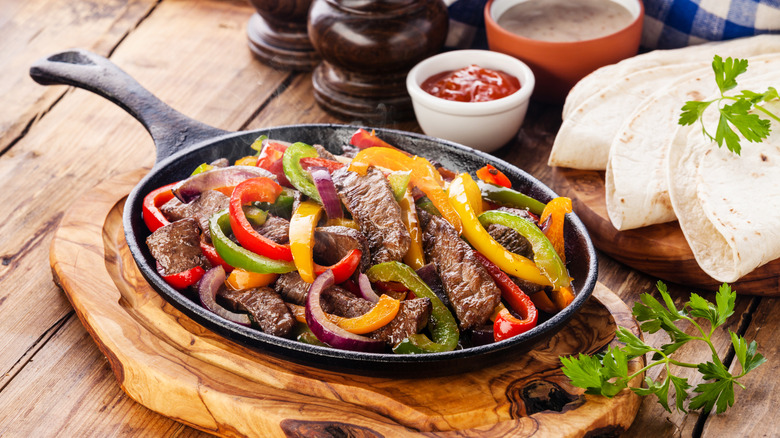
Lisovskaya/Getty Images
How many times have you been heartbroken when a waiter carrying a sizzling plate of fajitas walked right past your table without stopping? Mexican restaurant menus are packed with drool-worthy dishes, which makes ordering tricky. The theatrical entrance that fajitas are known for has made everyone question their decisions at least once when they order something else.
The wonderful news is that it is possible to recreate the magic of restaurant-style fajitas in your own kitchen, down to the sizzling platter. With some smart shopping, thoughtful planning, and high-quality ingredients, you can soothe your aching heart and stomach.
Arnie Segovia, creator of the popular YouTube channel Arnie Tex, and Jesse White, manager of the Phoenix branch of Valle Luna, were happy to dish out some chef secrets. Read on if you want to get to the bottom of why fajitas always taste better at Mexican restaurants, and what you can do to make yours more like what you'd find at your city's tastiest and most authentic Mexican joint.
Mexican restaurants always choose the right cuts of meat
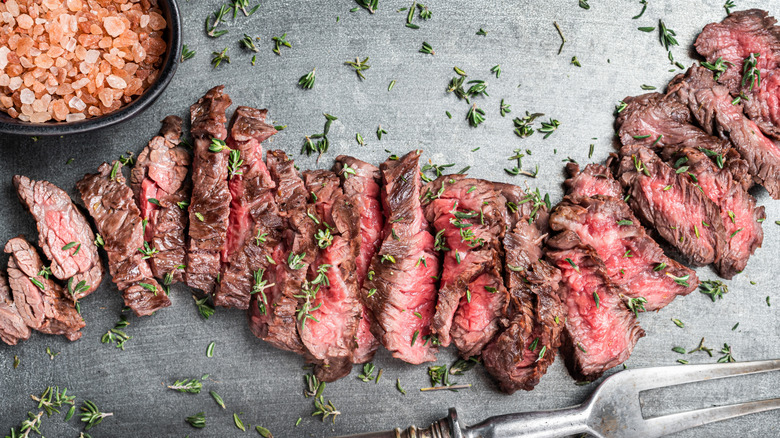
Mironov Vladimir/Shutterstock
Meat is the star of any fajita, so the kind that you choose matters a great deal. If you feel frozen when you're scanning the meat aisle of the grocery store, getting some advice from chefs can help you avoid bland or tough fajitas. Jesse White shared that Valle Luna uses chicken breast, shrimp, steak, and center-cut pork loin strips. When reflecting on his favorite, he said, "I think that all of these options carry well onto our Fajita Skillet, but personally I like the pork and shrimp best!"
Arnie Segovia is on team steak. He said, "The best meats to use for fajitas are the original fajitas, of course, and that's skirt steak. Inside and outside, skirt steaks are the best." However, he thinks that other types of beef can work well in a fajita: "Other cuts, such as flank steak and flap meat, also known as bavette, are also very popular for fajitas." Sirloin fajitas are also a staple in his home, as "they have a great balance of tenderness, flavor, and price."
Segovia urges home cooks to also pay attention to the quality of their meat. He said, "And a good quality meat is the most important ingredient. I like to buy prime cuts or at least choice grade." Understanding steak grades will make navigating the grocery store much less intimidating. You'll also learn how to get more value for your meals.
Trimming gristle and thinly slicing the meat leads to a melt-in-your-mouth texture
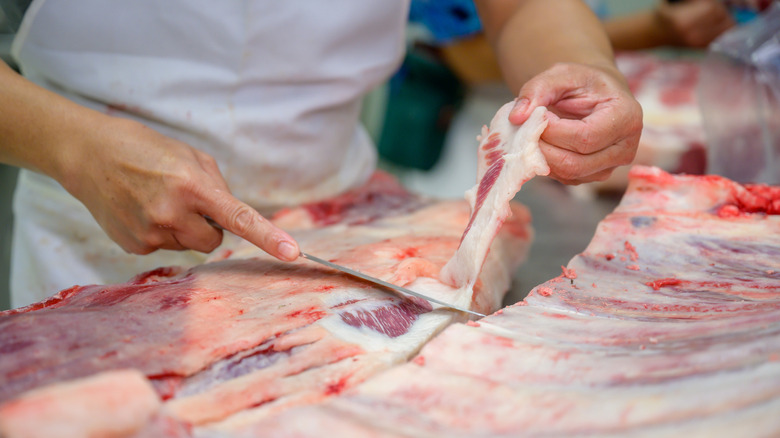
BELL KA PANG/Shutterstock
You're not done once you buy your meat and unload it into your fridge, though. Before you can start cooking, you'll have to do some prep work to create fajitas that can compete with Mexican restaurants.
Jesse White believes that taking a few extra minutes to trim your meat before marinating is always worthwhile. He said, "Just trimming any of the gristle or 'silver skin' off of the steak, chicken and pork is the key." This can help you avoid chewing each bite for a long time without much payoff.
When it comes to cutting techniques, White shared, "With a good marinade soak, I don't believe a certain 'cut' is critical." This is good news for home cooks who are still working on handling a knife. Practicing Chef Andrew Zimmern's knife hacks can help you feel more confident.
How does Arnie Segovia slice his fajita meats? "Slicing fajitas on the bias is often a technique used when the meat is a tougher cut, so cutting slices thin and on the bias and against the grain does help make each bite a little bit softer and easier to chew," he said. "When you cut against the grain, you basically shorten the grains, much, much shorter, and it makes it a lot easier to chew as well."
Marinating the meat perfectly is a balancing act that restaurants have mastered
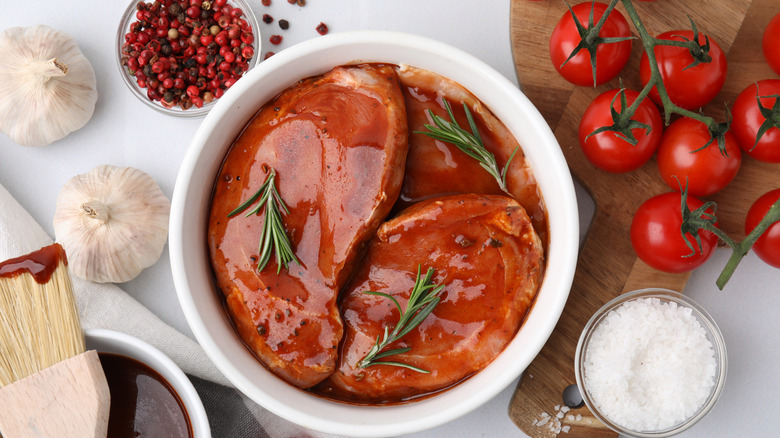
Liudmila Chernetska/Getty Images
Beginner home cooks may be under the impression that professional chefs marinate their meats solely to impart flavor. However, marinade also plays a huge role in tenderizing meat for the optimal texture. Both White and Segovia love using pineapple juice. White said, "We hand cut and marinate our fajita meats for a minimum of 24 hours. While our actual recipe is a secret, pineapple juice is a key ingredient." Segovia agreed, saying, "I also like to use pineapple juice or orange juice for tenderizing, but vinegars work well too." Not only does pineapple add a succulent, sweet taste, but the acidity works wonders for breaking down tough meats.
Segovia explained, "For tenderizing powders, you can also use papain, which is from papaya, or bromelain, which comes from pineapple. Those are the most popular powders for tenderizing meats." Make sure you're aware of the top mistakes people make when tenderizing their meat so you don't ruin your fajitas.
What else can you add to your fajitas marinade to maximize the flavor? Segovia stated, "A good marinade needs acid, oil, and seasoning for flavor." For saltiness, Segovia recommends soy sauce and Worcestershire. "I also like to add more flavor with garlic, onions, lime juice, and chili powders," he said. His final secret is that home cooks can use achiote, which comes from annatto seeds, in their marinades to give the meat a gorgeous red color.
Mexican restaurants cook with hot flat top griddles to develop a beautiful char

aishwarya young/Shutterstock
It's totally possible to make yummy crockpot fajitas or use a frying pan, but if you want to copy Mexican restaurants, you can start by investing in a flat top griddle. White confirmed that this tool will come in handy when you're whipping up fajitas. He shared, "We cook each Fajita Skillet fresh to order on our hot flat top griddles." Fans of ArnieTex may notice that Segovia also uses a griddle while cooking fajitas on YouTube. Since they're large and can reach high temperatures, they're perfect for ensuring that as much surface area of the meat can come in contact with direct heat.
If you don't have a flat top griddle, don't despair. Segovia said that you can still make your meat taste better with a special approach. He explained, "The first secret to cooking perfect fajitas is high heat and flipping often to develop good color and some char while retaining the most moisture inside the meat." This means that your best approach for using a frying pan may be cooking your meat in smaller batches. The last thing you'd want to do is overcrowd your pan and wind up with soggy meat. If you're working on a grill, Segovia urges home cooks to always clean the grates beforehand.
Chefs are precise with internal temperatures to avoid overcooking the meat
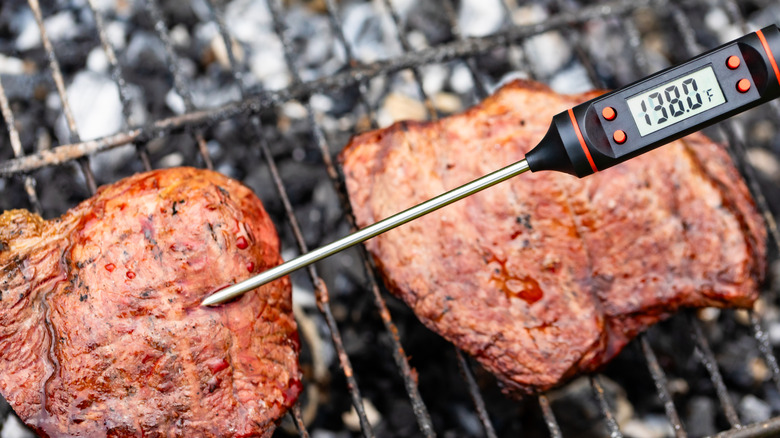
Naumoid/Getty Images
In addition to using high heat and regularly flipping the meat, Segovia instructs home cooks to avoid cooking fajita meat for too long. "The second secret, especially for newer cooks, is to not overcook the meat," he said. "Use a meat thermometer and cook to medium or medium rare temperatures, being somewhere between 130 and 137-ish. But basically, again, don't overcook the meat unless of course you like a firmer chew." This advice applies to beef, which is Segovia's favorite kind of fajita meat. If you're working with chicken, pork, or seafood, you need to make sure that the final product is at a safe temperature to eat so you don't get sick.
According to the U.S. Department of Agriculture, pork and seafood should be at least 145 degrees Fahrenheit, poultry should reach 165 degrees Fahrenheit, and ground meats should be 160 degrees Fahrenheit. Experienced home cooks can usually tell when their meats are finished just by looking, but it's good to get into the habit of double-checking your work with a meat thermometer.
Cooking with a high-quality oil makes all the difference
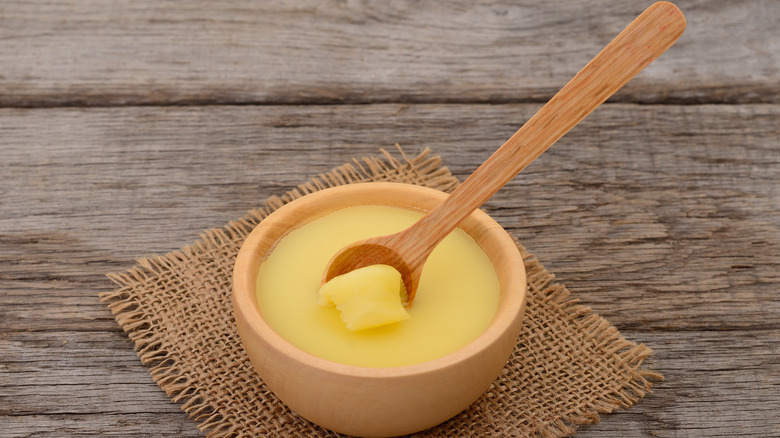
Tsekhmister/Getty Images
Many home cooks have a hard time choosing the right cooking oil, but this mistake can affect the quality of your meals. For example, lots of people believe that frying with extra-virgin olive oil can make their dishes healthier, but EVOO has a lower smoking point compared to more processed olive oil varieties, meaning that it's actually not the best option.
Arnie Segovia's go-to fat isn't even an oil. He prefers ghee. "I like to use ghee, where you can get that umami buttery flavor," he said. Not only does ghee enhance the depth of flavors, but it also has a high smoke point, which is essential for fajitas. This means that you can sear your meat to perfection without worrying about an unpleasant charred flavor.
Vegetable oil may not be as glamorous, but it's always reliable when you're in a pinch. Its high smoke point and mild flavor will let your fajita meat shine. Grapeseed oil and avocado oil are some other honorable mentions that you may want to keep in your pantry for pan-frying.
Bouillon adds extra flavor during the cooking process
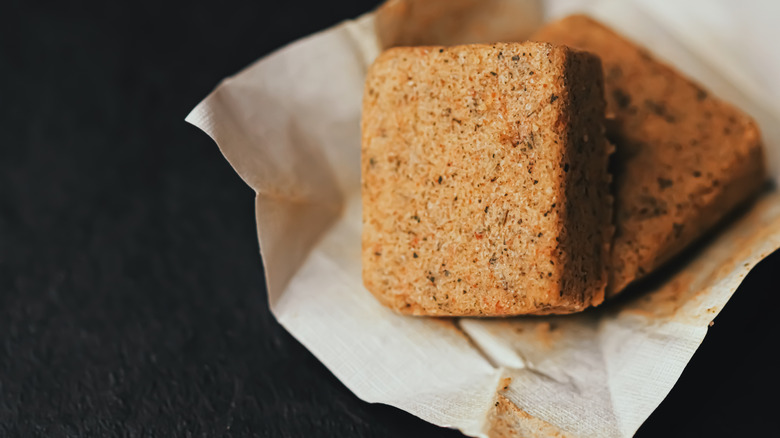
Anneleven/Getty Images
With a robust marinade, you don't need to do much else when it comes to seasoning your fajitas. However, Segovia sometimes adds a little extra savoriness to his fajitas with a humble bouillon cube. "You can also add a little beef or chicken bouillon while sautéing the fajitas for an extra pop of flavor," he said. "But be careful, because they're loaded with a lot of salt too."
If you're wondering why your homemade food never tastes as good as when you dine out, your taste buds are probably longing for that extra salt. Considering that some of the saltiest menu items at popular restaurant chains go beyond double the recommended daily sodium limit, it's no wonder that adding a bouillon cube can take your fajitas to the next level. It's fine to treat yourself every now and then, but your heart will thank you if you try to be mindful of your sodium consumption.
Bell peppers and onions are must-have toppings, but other veggies can enhance the flavor
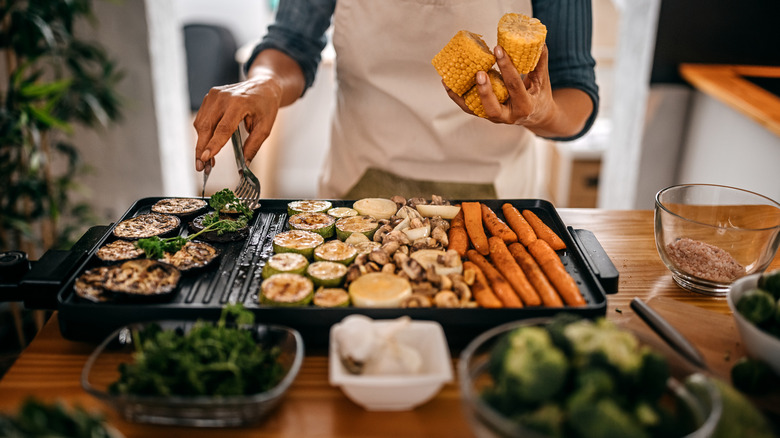
Mixetto/Getty Images
Classic fajitas always come with bell peppers and onions. This combination is juicy, sweet, and a little crunchy. "Our standard veggies are a mixture of white onions, and red and green bell peppers," Jesse White said. "We honestly don't really stray too far from that time tested recipe."
Arnie Segovia agrees that sliced bell peppers and onions are non-negotiable. The presentation of these veggies matters as well since Mexican restaurants take a build-your-own-fajita approach. He said, "Now, when using a grill or a pan with sliced fajitas, it is pretty traditional to use bell peppers and onions, and cooked and served along with the sliced fajitas. But for a surprise ingredient, you can also use shiitake mushrooms for an extra good beefy flavor."
If there are specific vegetables you adore, feel free to add them to your fajitas at home. They may not be traditional, but you'll love them since they're customized to your palate. Some options you might want to try include corn and even roasted sweet potatoes.
Pre-cooking the veggies ensures the meat stays hot and juicy
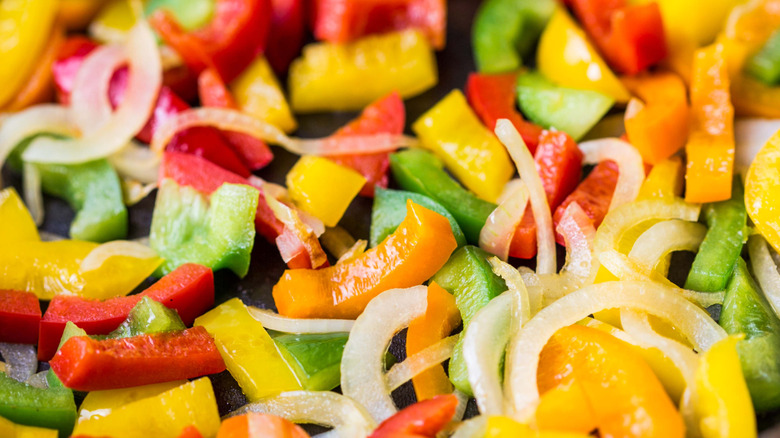
Maria_lapina/Getty Images
Every home cook knows how stressful it is trying to juggle multiple tasks while also keeping an eye on what's happening in the frying pan. To avoid panicking, White suggests that home cooks plan ahead. He explained, "Consider pre-cooking the veggies a bit beforehand so that they get softened up nicely and aren't too 'raw' when your meat is done quickly, especially with steak or shrimp."
Doing this will allow you to focus on each step calmly. You can trim your meat and marinate it overnight for maximum flavor. Before you turn your stove, grill, or flat top griddle on, pay attention to your knife cuts as you slice through your fajita veggies.
Giving the veggies a head start in the cooking process will ensure that they're at your ideal level of doneness. Since White and Segovia believe that the temperature of the meat is crucial, this trick makes it much easier to prioritize the meat without letting the veggies suffer.
Mexican restaurants have mastered the flavor profile of fajita toppings
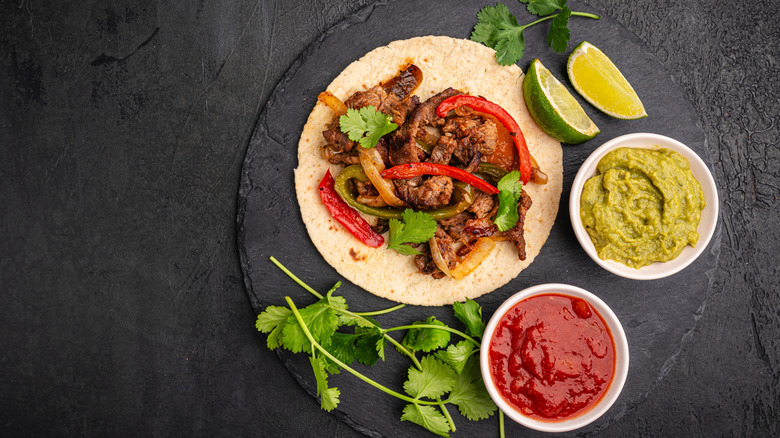
Goskova Tatiana/Shutterstock
Traditional fajitas are pretty minimalistic when it comes to the number of ingredients used while assembling. The meat is the star, the bell peppers and onions play a supporting role, and the tortilla is a tasty vehicle. What should you put on top of your fajitas if you want them to taste as good as the ones you can find at your local Mexican restaurant?
To avoid overpowering the succulent meat, bell peppers, and onions, Jesse White keeps it simple. "We stick to homemade fresh guacamole, sour cream and traditional 'taco' garnishings (lettuce, diced tomato and shredded cheese)," he said.
Arnie Segovia also takes the less-is-more approach. When you use high-quality, homemade ingredients, the fajitas can come together in a brilliant way. "My favorite toppings for fajitas are (...) a good homemade pico de gallo or a homemade fire-roasted salsa, plus some guacamole," he shared.
Garnishing with some sliced limes could also be nice if you're a fan of citrus. Trust in the flavor-building process and give these stellar ingredients space to shine on your taste buds.
The best Mexican restaurants prepare homemade salsa instead of using jarred salsa
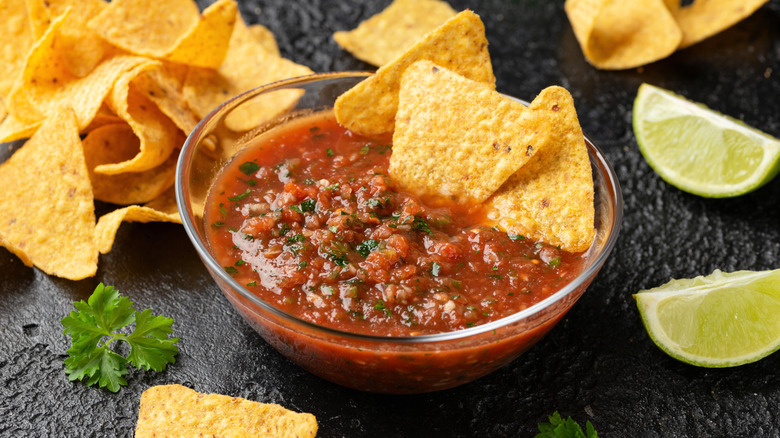
Drong/Getty Images
You should never be served salsa from a jar when you're visiting a Mexican restaurant. White and Segovia acknowledge that no fajita is complete without some refreshing, homemade salsa for dipping or spooning on top. "I always make my own salsas for fajitas, and I have several salsa recipes," Segovia said. "Many you can find in my cookbook, 'ArnieTex.' I use some of these salsas on a regular basis, but probably my favorite one is with a blend of tomatillos and Roma tomatoes, plus garlic, onion, and serrano peppers. And for a little more heat, I'll throw in a little bit of árbol or pequin peppers, too. Simple but delicious."
Valle Luna also treats its customers to fresh salsa. White shares that the team prepares two different types to suit people's spice tolerance. "We have a mild 'chunky' style salsa with fresh diced tomatoes, white onions, green chiles and cilantro as the main base, along with a hot sauce that is smooth puréed with some 'kick' to it," he said. "A good homemade green tomatillo pairs great as well!"
Even though making your own salsa can be a breeze, sometimes we're all in need of a quick weeknight dinner. If you're okay with cutting corners, you can check out our ranking of store-bought salsas so you'll know which one will pair best with your fajitas.
Restaurant-style fajitas are never served on store-bought tortillas
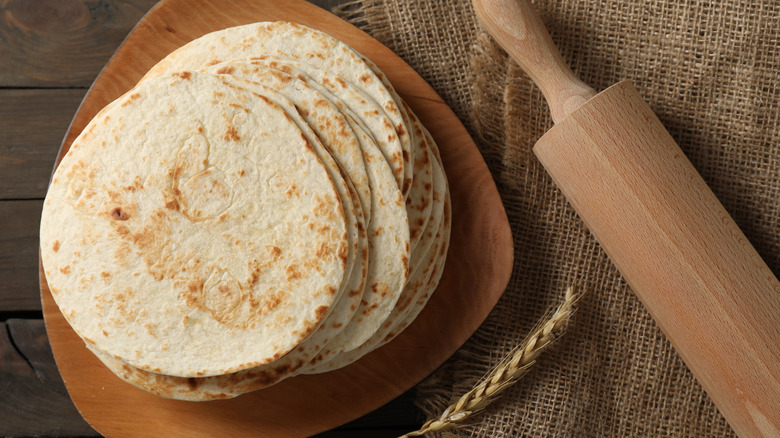
New Africa/Shutterstock
Tortillas may not be as exciting as perfectly marinated skirt steak or shrimp, yet they bring the whole dish together. You can't have the best restaurant-style fajita with store-bought tortillas. "I would say it's absolutely worth it to make your own tortillas," Segovia said. A tortilla press could be a worthwhile investment if you eat a lot of tortillas, but it's not necessary. It's easy to prepare homemade tortillas with flour, oil, salt, baking powder, water, and a rolling pin.
One way that White saves time at home is by buying ready-to-cook tortillas. "I do like buying fresh 'uncooked' tortillas and grilling them at home for a really fresh taste," he said. "As for store bought, I do not have a favorite."
Segovia agrees that homemade tortillas reign supreme. "There is no store-bought tortilla that can match a homemade fresh tortilla," he said. "However, sometimes it is about time availability, so we often buy H&B Bakery for flour tortillas, and El Milagro is our favorite brand for corn tortillas."
Mexican restaurants invest in high-quality kitchen appliances to make tastier fajitas
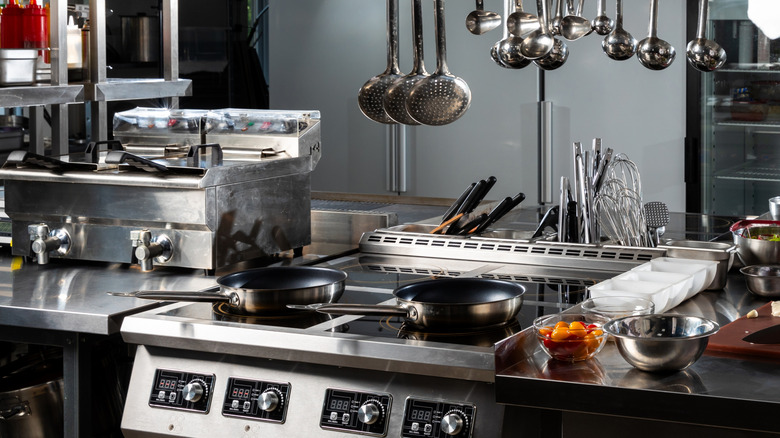
mariakray/Shutterstock
Cooking fajitas can be sweaty work. To avoid injuring yourself, Segovia suggests having two tools in your arsenal. "For grilling, I highly recommend using restaurant-quality tongs and a good, sharp 10-inch chef's knife for slicing," he said.
We all know now that flat tops are superior for cooking fajitas. White said, "Using a flat top 'Blackstone' type grill is a great way to do them if you have one at home." If you don't have a flat top, steer clear of any non-stick pans. "When cooking in strips with the veggies, a good stainless steel, carbon steel, or cast iron skillet will do a great job," Segovia explained. "Those non-stick pans really do not develop a good char or a good color on your fajitas, as well as the previously mentioned pans."
Don't be intimidated by pots and pans that don't have a non-stick coating. Not only will that barrier break down over time and cause food to stick, but the coating also contains chemicals that are harmful to your health. Take the time to master cooking with a cast-iron skillet and other varieties.
Mexican restaurants make fajitas a memorable dish by serving them on a sizzling platter
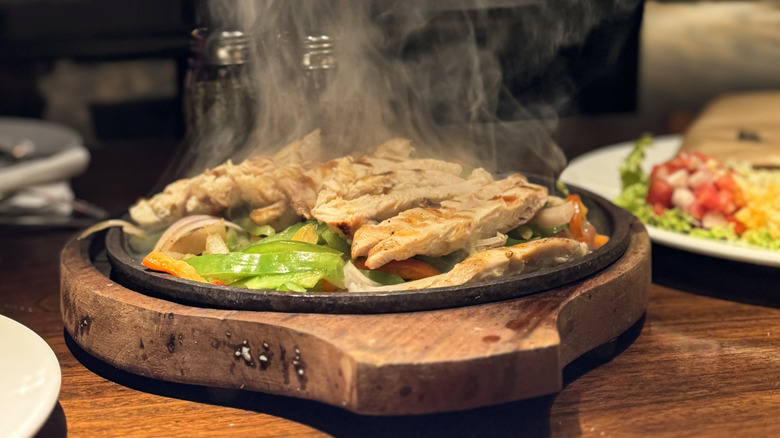
Mtreasure/Getty Images
Taking steps to ensure that the flavors and textures are incredible goes a long way toward creating fabulous fajitas. However, no one can deny that the sizzling platter that they're served on is what makes the biggest impression during a restaurant meal. Some people always order fajitas when they go out to eat, despite preferring other Mexican dishes, simply because they love the drama of the presentation and how jealous every other diner is when the waiter walks by.
Jesse White agrees that presentation is key. While creating a sizzling platter at home can be a little dangerous, it is possible. He said, "Serving on a sizzling cast iron platter is a great presentation if you have the ability to heat it up hot enough at home in the oven for table service that will impress your guests!"
Arnie Segovia has shared on his YouTube channel that the secret to achieving that fun, sizzling sound that helps spread the mouthwatering aromas is heat and water. After you heat a platter in your oven or on a grill, add a few drops of water right before serving. Just make sure your face or arms aren't too close to the platter since it'll be hot.



